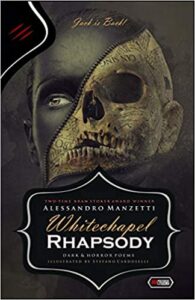A note from the editor (that’s me) :
We are midway through October and Monster Librarian still needs to raise the funds to pay for our hosting fees and postage in 2021. If you like what we’re doing, please take a moment to click on that red “Contribute” button in the sidebar to the right, to help us keep going! Even five dollars will get us closer to the $195 we need to keep going at the most basic level. We have never accepted paid advertising so you can be guaranteed that our reviews are objective. We’ve been reviewing and supporting the horror community for 15 years now, help us make it another year! Thank you! And now our review of Whitechapel Rhapsody by Alessandro Manzetti.
Whitechapel Rhapsody by Alessandro Manzetti (Amazon.com)
Independent Legions Publishing, 2020
ISBN: 978-88-31959
Available: Kindle edition, Paperback
Ever since Jack the Ripper prowled the streets, he has been the worst kind of nightmare, the shockingly brutal and chilling reality that monster-men can be living among us unnoticed, watching and freely choosing fresh victims. In his new book of poetry, Whitechapel Rhapsody, Alessandro Manzetti uses words from The Ripper’s letters to the police, information about the women and their possible murderers, and even one of the autopsies to access the mind of a killer who has never been identified for certain.
In “The Lair”, which begins the book, and in the rhapsody poems (“Sick Rhapsody,” “Entangled Rhapsody,” and “Madhouse Rhapsody”) which appear at intervals throughout the collection, we are plunged into the ugly, sordid, sick environment of physical and spiritual contagion that was the setting for the murders, if not the spawning ground of the murderer. Against this background, the poems describe the killer as a macabre artist who vows to his victims, “I will make art of you” and causes them to be “carved” by his “iron brushes,” his “long-bladed knife accurate like a Mozart composition.” True to The Ripper’s artistic vision, there is a focus on color, especially shades of red blood and the textures of the organs of the human body in each “still life.” This is the portrait of a demented artist whose imagination is a “giant” that “can feel the vibrating legs of a grasshopper ready to jump on a leaf of a remote island.”
This extreme sensitivity is on display in “She Knew My Name” which riffs on Poe’s “The Raven.” Both poems are about the narrator’s mind and what is happening inside it, how each is processing his experiences. Both narrators indulge in their madness, and that has an emotional impact on the reader. Manzetti confirms that it is not the facts of blood or death that most inspire terror in a reader but the evil imagination of the poem’s speaker igniting the active imagination of the reader’s “dark side.” This fascination that ordinary people have with horror is apparent in “Madhouse Rhapsody,” a reminder of Bedlam where the English citizenry actually went to enjoy the suffering of the imprisoned mentally ill as live entertainment. Also, many of the poems mention the opium, syphilis, perversions, and abuses which were common at the time and could be the source of madness.
Even though it is unlikely we will ever know Jack the Ripper’s identity or what caused him to kill, Whitechapel Rhapsody pulls back the curtain enough for us to fully feel the evil behind the facts and sense the cold, hard facts behind the dark poetic imagination.
Recommended.
Reviewed by Nova Hadley





Follow Us!